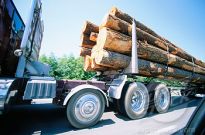 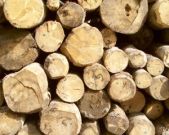 |
|

Lumber Directory Database
The most comprehensive listing of Canadian solid wood and pulp manufacturers anywhere, Madison's Online Lumber Directory has been published for over 60 years. Company information includes contacts, tree species, rough and finished lumber sizes, lumber production volumes, countries of lumber export, and much, much more. A sample viewing of Madison's Online Directory is available HERE, the full database contains more than 1,799 individual solid wood and pulp producer entries. Further details and a link to our Madison's Directory order form is HERE.†
Read more below for information about our Directory, how it was created and what it can do for you .
HISTORY OF MADISON'S LIVE ONLINE LUMBER DIRECTORY
In 1952, Peter Madison started a local Vancouver
publication tracking the west coast lumber industry called Madison's
Lumber Reporter. Madison's quickly grew to track lumber and panel prices
across Canada, then soon all of North America. In 1953 Madison's
released a small printed book detailing British Columbia's lumber
producers; primary sawmills, secondary remanufacturers, plywood mills,
pulp mills, and cedar mills. It was not long before the book grew to
cover the entire Canadian solid wood manufacturing industry.
In combination with the weekly lumber and panel
price guide, the annual Madison's Directory has served to keep the
forest products' industry, and anyone interested in it, informed about
who the players are, including the producers, the wholesalers, the
transporters, and the reloads, for the past 60 years.
Originally the listings were grouped by region.
The chapters of the book were divided into provinces, then further
categorized by type of producer. To aid readers, there were four
extensive indexes; by company name, by location, by contact name, and by
grading agency mill number. This last one was especially useful if
someone received a load of wood but had no way to contact the supplier;
by looking at the grade stamp and referencing Madison's Directory, mill
managers and lumber retailers were quickly able to get to the source of
that wood.
Information listed in the Directory goes far
beyond simply company names, addresses, phones and emails, and contact
names. Company listings are free, and the scope of each listing is up to
the discretion of individual companies. Most, however, fill out
Madison's listing forms fully. Information includes the above, as well
as; timber species handled, rough sizes, surfaces sizes, product mix,
production volumes, additional services, kiln capacity, countries of
export, preservatives used, treating facilities, panel thicknesses,
panel sizes, distribution yards, number of employees, grading agency
membership, certification, and notes, which is mostly used by specialty
operators.
A typical mill listing, in this case a primary manufacturer in British Columbia, contains this level of detail:
|
|
|||
|
Mill ID# |
92 |
||
|
Name of Mill |
Foothills Forest Products Inc. |
||
|
Type |
Mill |
Region |
Canada, BC |
|
Contact Address |
PO Box 180, Grande Cache, AB T0E 0Y0 |
||
|
Phone |
780-827-2225, Sales Phone - 250-992-7471
|
||
|
Fax |
780-827-2246, Sales Fax - 250-992-5753 |
||
|
Email |
info@foothillsforestproducts.com |
||
|
Website |
www.foothillsforestproducts.com |
||
|
Mill Location |
|
||
|
Contact Persons |
CEO - Joe Cerasa , Mill Manager - Aaron
Davis |
||
|
Species |
Lodgepole Pine 85%, White Spruce 10%,
Balsam Fir 5% |
||
|
Rough Sizes |
|
||
|
Surfaced Sizes |
2x3 to 2x6, 6ft to 16ft |
||
|
Products |
dimension (2x4, 2x6 to 16ft), fuel pellets |
||
|
Production |
200 Mfbm/8hr shift, 50 MMfbm/yr
|
||
|
Services |
planing, paper wrapped |
||
|
Kiln Capacity |
750 Mfbm/charge |
||
|
Shipping |
truck, rail (CN) |
||
|
Export |
|
||
|
Preservatives |
|
||
|
Treating Facilities |
|
||
|
Thickness |
|
||
|
Sizes |
|
||
|
Distribution Yard |
|
||
|
Employees |
45 |
||
|
Grading Agency |
AFPA Mill No. 045 |
||
Having entered the digital age, the weekly
Madison's Lumber Reporter is sent by email every Friday, and the annual
Madison's Lumber Directory is now available in a searchable online
format. One reason Madison's is a favourite among the industry is that
every single listed company is contacted once a year to update their
information. Critical contact or production details are then entered
into the database so subscribers are constantly provided with the most
current information possible.
Users of Madison's Live Online Directory include
log harvesters and transporters, lumber producers and salespeople,
lumber brokers and wholesalers, railways, ports, reloads, builders,
retailers, governments, libraries, universities and colleges, grading
agencies, industry groups and organizations, and a large number of
international customers looking to stay informed on the North American
lumber industry.
DETAILS ON THE SETUP OF MADISON'S LIVE ONLINE LUMBER DIRECTORY
Having come up through history since 1953, the
Directory was of course not in a database. At first the book was typed
out every year, then eventually was produced through an old-style word
processor. Starting in the 1990's the book was created in
desktop publishing software. The information was entered in the
order that the book was printed; by province first then by mill type.
Transferring the text file to a database was a
tricky project, involving many steps to make sure the data sets flowed
correctly. Once that work was done, creating a user interface for
readers to easily be able to view, and search, the database on the
internet provided further challenges.
Here are some comments from our programmer:
This was a challenging project indeed and I found the conversion process required almost as much time as the entire programming end of the setup. First we used special software to convert the original PDF files into Word format. That result had to be examined and for which we wrote a lengthy macro to help automate much of the conversion. Then the files had to be carefully sifted to look out for possible exceptions or glitches to the conversion. We worked closely with the client to spread the workload. By providing clear instructions and performing complex, back-end programming, the client was able to perform a lot of the manual work itself. Not only is the client best suited to examine the data to make sure all the figures fell in their proper place, but this measure allowed it to save on costs.
Once the conversion into Word was complete and controlled for exceptions, the long conversion into Excel format began, which required that we write up a Perl script, again to automate much of this process. The array of data had to be transposed from a loose text file format:
Mill
name:<tab>Bobís Mill
Mill
address:<tab>1234 Street
Mill
region:<tab>British Colombia, Canada
to:
|
Mill name |
Mill address |
Mill region |
|
Bobís Mill |
1234 Street |
British Colombia, Canada |
and all records correctly lined up under the correct field header. Our script helped a lot but there were many exceptions to the data which complicated the conversion, so the records needed careful examination. Once again, we worked together with the client to reduce costs and ensure accuracy.
Once the data was in Excel format, it was a simple issue of converting it to online database format. For this project we chose sqlite, which is similar to mysql but a lighter database format and easier to work with. This in conjunction with php and the occasional javascript produces the final version. If you have some data in an old format that you would like to modernize into an online and functional database, Iíd welcome the opportunity to look at it. Please feel free to email me.
ECONOMIC IMPORTANCE OF THE LUMBER INDUSTRY
Forest products are one of Canada's largest
exports to the United States. Softwood lumber specifically is a very
important trade item, comprising 21.5 billion board feet of shipped into
the US in 2005. The value of Canadian forest products exports in 2005
were $36.4 million, while in 2009, due to the economic downturn,
Canadian forest products exports dropped to $19.5 million. Of that,
solid wood exports were valued at $18.8 million in 2005 and $6.8 million
in 2009.
Canada has historically enjoyed approximately
30-33 per cent of market share in the US lumber industry. When US home
building is up and Canadian wood exports exceed that amount, US lumber
producers -- particularly southern yellow pine sawmills in the southern
US -- complain to a powerful lobby group which works for their interests
in Washington, DC. US home builders, trades, and realtors do not support
the US lumber lobby, but are not strongly organized therefore their
voice is not heard nearly as powerfully in the US Congress. In addition,
significant amounts of US lumber producers, specifically on the west
coast, actively do not support the US lumber lobby.
The Canadian lumber industry is also not very
well organized, with many regional agencies and organizations taking
only local interests seriously but ignoring the national picture. A good
example of this would be the atlantic provinces, where timberland is
largely privately owned. This region stays out of tricky trade disputes
between Canada and the US entirely, while Quebec and British Columbia
seem to be involved in a never-ending list of complaints and
international arbitration.
The root of the problem is, and always has been,
that Canadian timberlands are largely owned by the public and managed by
provincial governments, while US timberlands are owned by private
timberland investors. The timber pricing system in Canada varies by
province and is not well understood in the US, which makes it a perfect
foil for claiming that Canada subsidizes its forest products industry by
making timber available to lumber producers at a reduced cost.
Disputes over softwood lumber exports have been
going on between the US and Canada since 1889 and continue to January
18, 2011 when the US launched a new arbitration in international court
against British Columbia which has been valued at upwards of US$400
million.
Despite political upheaval, forest fires,
transportation problems, labour disputes, storms, and beetle
infestations, the export of forestry products from Canada to the US
continues. Canada's market share in 2010 had decreased to 24 per cent,
but is expected to recover slowly through 2011 then more rapidly as the
US home building market emerges from the problems created by
zero-interest mortgages of 2003 to 2006.
Meanwhile Canadian lumber exports to other
countries, specifically China as a new customer and Japan as a returning
one, are growing at much greater rates than the US market is collapsing.
Significant lumber mill capacity out of British Columbia has been
diverted from the Asia from the US. Several sawmills have retrofitted to
produce lumber in metric sizes and are shipping their entire product mix
overseas. These mills will not reconfigure back to board feet to ship
into the US when that customer base returns.
In addition the volume of timber supply
available in British Columbia will begin decreasing in 2011 and last at
least 30 years in the wake of the mountain pine beetle and the hundreds
and hundreds of square kilometres
of dead forest left behind.
There is a serious question about where the billions of board feet per year the US is going to need when economic recovery arrives is going to come from. That country is seriously underbuilt, with demographics remaining constant but new home building severely restricted on an annual basis since mid-2006. There is a limited timber supply available domestically, and the US will likely find the usual easy availability of wood from Canada greatly reduced due to overseas exports and diminished log supply.
History of the Lumber Industry
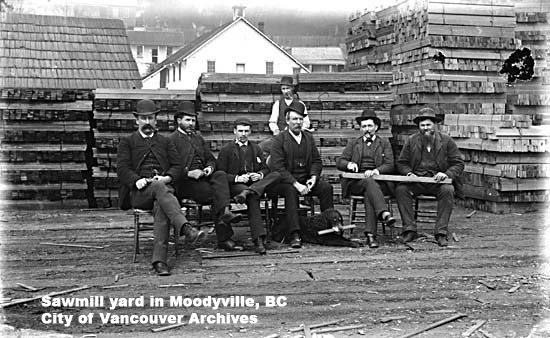 |
As the 20th century progressed and Canada and
the US continued developing, more wood was needed thus more sawmills
sprang up. As well, a wider variety of products were needed so more
sophisticated processing techniques came to be. In addition to primary
mills, which saw raw logs, secondary remanufacturing and veneer sawmills
came into being. Millwrights and woodworkers were in high demand for
finishing, flooring, mouldings and boards to go into the thousands and
thousands of new homes being built out of wood across the continent
every year. |
|
Harvesting timber for building and other uses
began immediately when Europeans came to North America. Both in the
United States and Canada, wood from trees was used to settle and develop
the continent. As the population moved west, even bigger and sturdier
timber was found, specifically Douglas fir and cedar on the west coast. At first lumber was used for local projects. As towns were built up, shipments of processed wood products began going to remote areas for new building. Sawmills ran logs sourced locally then sent lumber along newly-built rail lines wherever it might be needed. Soon entire towns grew up around a single sawmill operation. Softwoods, or conifers, like spruce, pine, fir and hemlock are traditional used in framing lumber. Also called dimension lumber, these products -- including 2x4's, studs, fingerjoint and I-joists -- are used to hold up the structure of a home or small building. Hardwoods, like maple, oak, alder, birch and cherry, are used for decorative features in interiors and exteriors. |
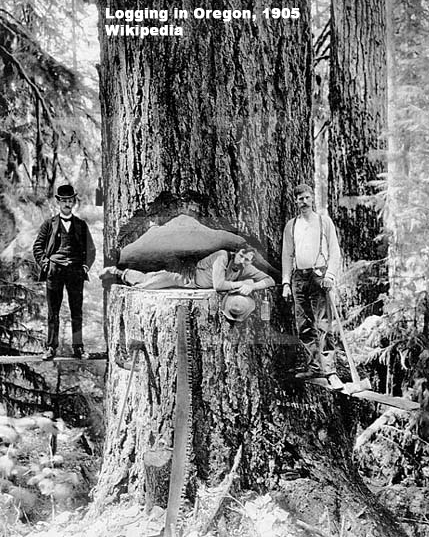 |
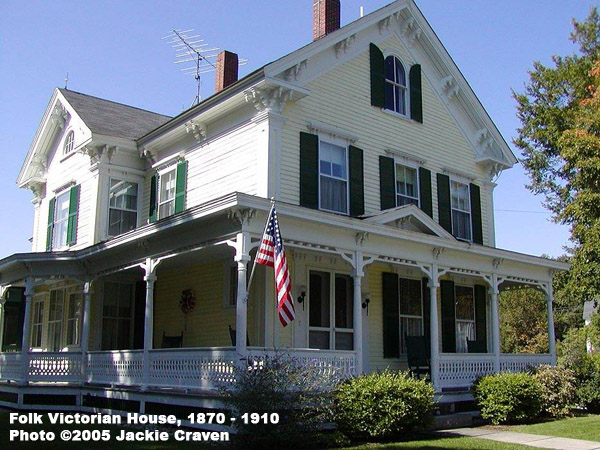 |
By the mid-century there were enough primary
sawmills and secondary remanufacturing plants in Canada and the United
States for companies to begin exporting wood products. Europe and the UK
were natural choices as major post-war rebuilding was taking place. Soon
Japan also came in as a serious customer for North American wood
products. Today new customers like China, Vietnam, Korea and the middle
east are serving to keep demand for processed lumber products high. |
|
Using wood for building is a green and
sustainable alternative to more expensive and less carbon-neutral
components like concrete or steel. A tree not harvested will eventually
burn, fall and decay, or become host to insects and pests. A healthy
northern pine tree grows to be about 80 years old before reaching the
end of its useful life span. As the wood degrades it releases carbon
into the atmosphere. If the tree is felled when the cellulose is still
good, that carbon is locked into wood products, and usually homes, for
40 to 60 years or more. New trees are planted, or regenerate naturally.
A growing tree absorbs several orders of magnitude more carbon than a
fully grown tree. |
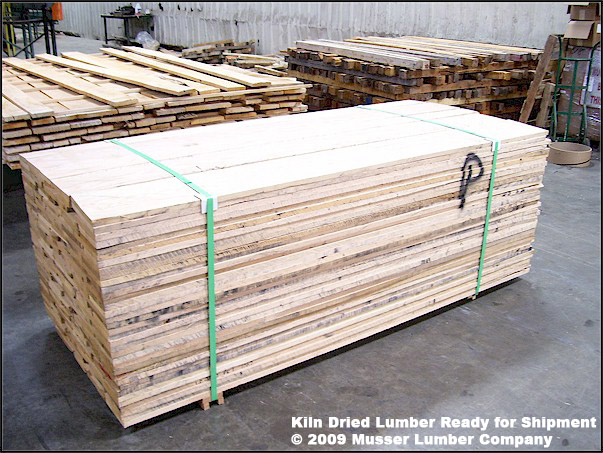 |
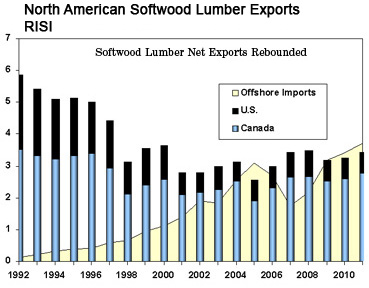 |
The days of clear cuts, slash and burn, and poor
environmental practices in the forests are over. Canada has always been
a leader in sustainable forest practices, and is now documented as a
country with some of the best forest management models in the world.
Lumber producing companies understand the importance, driven by customer
demand, of maintaining good harvest techniques and are voluntarily
members of such globally-recognized certification agencies as SFI and
FSC. |
|
As the 21st century gets underway, the North
American lumber industry continues to adjust to demands for lumber
products. For example, China's rebuilding after the devastating
earthquake in 2008 is focussing specifically on using dimension lumber
products. A major earthquake test in Japan in 2009 proved that a
seven-storey wood-framed building withstood an 7.5 magnitude earthquake
with barely a scratch. Other countries are also looking at building with
wood rather than traditional materials like brick, clay, concrete and
steel, due to safety concerns, sustainability and carbon issues, cost,
aesthetics, and durability. |
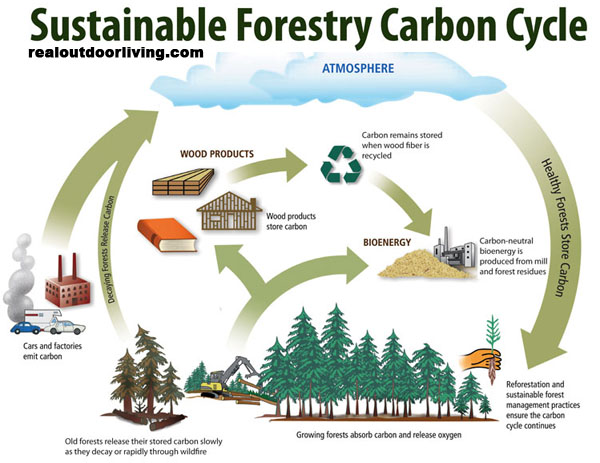 |
 |
North America's lumber manufacturers produce a variety of products and sizes, using a variety of species. A directory listing all sawmills and remanufacturers, and extensive details about company information including contact names, emails, product lists, services, grading agency memberships and countries of export is a critical tool for anyone involved in log harvesting or transporting, selling sawmill equipment, sawmill repair services, looking for sawmill employment, sourcing lumber and panel products, or otherwise interested in the North American forest products industry. |